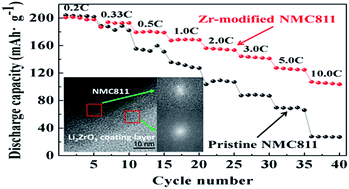Dual functions of zirconium modification on improving the electrochemical performance of Ni-rich LiNi0.8Co0.1Mn0.1O2†
Abstract
Trace amounts of zirconium (Zr) have been adopted to modify the crystal structure and surface of the Ni-rich LiNi0.8Co0.1Mn0.1O2 (NCM811) cathode material. During cycling at 1.0C, the Zr-modified NCM811 shows an improved capacity retention of 92% after 100 cycles, higher than 75% for pristine NMC811. In addition, the Zr-modified NCM811 is capable of delivering a discharge capacity of 107 mA h g−1 at a 10.0C rate, much higher than 28 mA h g−1 delivered by pristine materials. These improved electrochemical performances are ascribed to the dual functions of Zr modification. On one hand, part of the Zr enters the crystal lattice, which is beneficial for reducing the Li/Ni cation mixing and enhancing the crystal stability of the cathode. On the other hand, the rest of the Zr forms a 1–2 nm thick coating layer on the surface of the NCM811 cathode, which effectively prevents direct contact between NCM and the electrolyte, thus suppressing the detrimental interfacial reactions. Therefore, the Zr-modified LiNi0.8Co0.1Mn0.1O2 exhibited significantly enhanced cycling stability and charge/discharge rate capability in comparison with its untreated counterpart.



 Please wait while we load your content...
Please wait while we load your content...